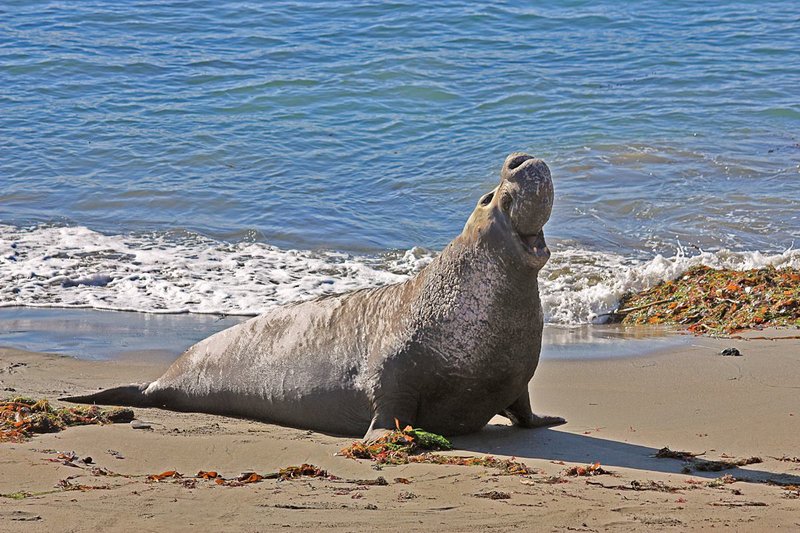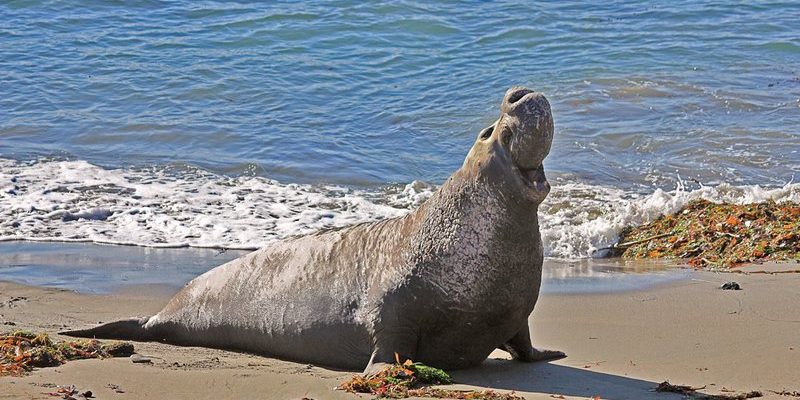
You might be wondering why these seals are interesting enough to dedicate an entire article to. Let me explain: they lead thrilling lives filled with remarkable adaptations, complex behaviors, and even some surprising social structures. Just like how you might discover something unexpected about a long-time friend, there’s always more beneath the surface when it comes to these intriguing marine mammals. So grab a comfy seat and let’s dive into some cool facts about elephant seals.
1. The Size and Weight of Giants
When it comes to size, elephant seals are true giants of the ocean. Adult males can reach lengths of up to 20 feet and weigh as much as 2,000 pounds! That’s as heavy as a small car. Females are smaller but still impressive, averaging around 10 feet in length and weighing around 1,000 pounds. Imagine trying to lift a large suitcase filled with bricks—that’s a bit like what these seals are hauling around every day!
Their size is not just for show; it plays a crucial role in their survival. The bulk of their bodies helps them maintain warmth in cold waters. As they dive deep into the ocean for food, their large size gives them the stamina needed to spend long periods underwater—sometimes up to an hour without coming up for air.
2. The Mysterious Migrators
Elephant seals are champions of long-distance travel. They can swim thousands of miles across the Pacific Ocean during their annual migrations. Some populations are known to travel over 12,000 miles each year. That’s like walking from New York to Los Angeles and back again, all while swimming!
These migrations usually take place after their breeding season. After the hustle and bustle of mating, the seals head off to feeding grounds in the deep ocean, where they can find plentiful fish and squid. This migration is not just about survival; it’s also about exploring new territories and finding the best feeding spots.
3. Communication Through Blubber
Ever heard a loud, whale-like sound coming from a beach? That’s the elephant seal! They have a unique way of communicating, and it involves a series of loud barks, growls, and even snorts. These vocalizations are often used during mating season when males confront each other to establish dominance or attract females.
The sounds they make can travel long distances over the water and help them assert their territories. Imagine a deep, rumbling voice echoing across the beach—all part of their social dynamics. In fact, a single male can have a harem of females due to his vocal prowess and sheer size.
4. Amazing Adaptations to Life in the Ocean
Elephant seals have adapted wonderfully to their oceanic lifestyle. For starters, they can hold their breath for an astonishing 90 minutes while diving. That’s like holding your breath during a movie scene—only prolonged! They have special adaptations in their blood that allow them to store more oxygen, which gives them the ability to explore the ocean depths in search of food.
Their blubber, while making them hefty, is also essential for insulation against freezing waters. This thick layer of fat not only helps them stay warm but also provides energy reserves during their long migrations. What’s even cooler? Their eyes have a special membrane that allows them to see better in dark, murky water.
5. Unique Breeding Behavior
Breeding season for elephant seals is a wild spectacle! Males gather on breeding beaches, often fighting to establish dominance and win the right to mate. With loud roars and aggressive postures, they clash in dramatic battles that can sometimes leave them injured. It’s like a nature documentary unfolding right before your eyes!
After establishing their territories, males will attract multiple females, who come to breed and give birth. A single male can mate with several females during this short breeding period, which lasts just a few weeks. The females, on the other hand, give birth to a single pup after a gestation period of about 11 months—definitely a labor of love!
6. The Fascinating Pup Lifecycle
Speaking of pups, elephant seal babies are incredibly adorable! Newborn pups weigh around 70 pounds at birth and are covered in a soft, velvety coat. They spend their first month on the beach feeding on their mother’s rich milk, which is about 50% fat. This high-fat milk helps them gain weight rapidly—sometimes up to 10 pounds a day!
Once they are weaned, pups have to fend for themselves. This stage can be tough, as they must learn to hunt for food and navigate the ocean. It’s a bit like a teenager learning to drive; there’s a lot of trial and error involved!
7. Role in Marine Ecosystems
Elephant seals play a vital role in the marine ecosystem. As apex predators, they help maintain the balance of marine life by regulating the populations of their prey, like fish and squid. Their presence is essential for the health of the ecosystem, similar to how a keystone species supports the structure of its environment.
Moreover, when they molt, elephant seals shed their skin and fur on beaches, leaving behind organic material that enriches the sand and nourishes other marine life. It’s like nature’s way of giving back!
8. Conservation Status and Efforts
Despite their size and strength, elephant seals faced serious challenges in the past. They were hunted nearly to extinction for their blubber in the 1800s. However, thanks to conservation efforts, their numbers have rebounded significantly. Today, populations are estimated in the hundreds of thousands, showcasing the resilience of nature when given a chance.
Conservation efforts have included protecting key breeding and resting sites, as well as raising awareness about their importance in marine ecosystems. It’s like giving them a second chance to thrive and show just how amazing they can be.
9. Fun Facts You Didn’t Expect
There’s always something new to learn about elephant seals! Here are a few fun tidbits that might surprise you:
- Camouflage: Their mottled gray and brown skin helps them blend into the rocky shores, making it harder for predators to spot them.
- Molting: Elephant seals undergo a molting process where they shed old fur and skin. This can take up to a month!
- Social Animals: Though they may look solitary, elephant seals often gather in large colonies, especially during breeding season.
- Record Divers: They are among the deepest diving seals, reaching depths of over 5,000 feet in search of food.
These little-known facts showcase the complexities and wonders of these marine mammals.
10. How You Can Help
You might be wondering how you can contribute to the conservation of these magnificent creatures. Here are some ways:
- Visit responsibly: If you’re visiting elephant seal colonies, make sure to follow guidelines to minimize disturbances.
- Support conservation organizations: Donating to organizations dedicated to marine conservation can make a significant impact.
- Spread the word: Share what you learn about elephant seals with friends and family. The more people know, the more support we can garner for their protection.
Every small action counts when it comes to protecting our planet’s wildlife.
In conclusion, elephant seals are far more than just their size and appearance. They represent incredible adaptations, complex behaviors, and an important role in the ocean ecosystem. From their impressive migrations to their unique social structures, each aspect of their life tells a story of survival and resilience. So the next time you find yourself near a beach with elephant seals, take a moment to appreciate these amazing animals and the fascinating lives they lead. You’ll find there’s a lot more than meets the eye in these remarkable creatures of the sea.

